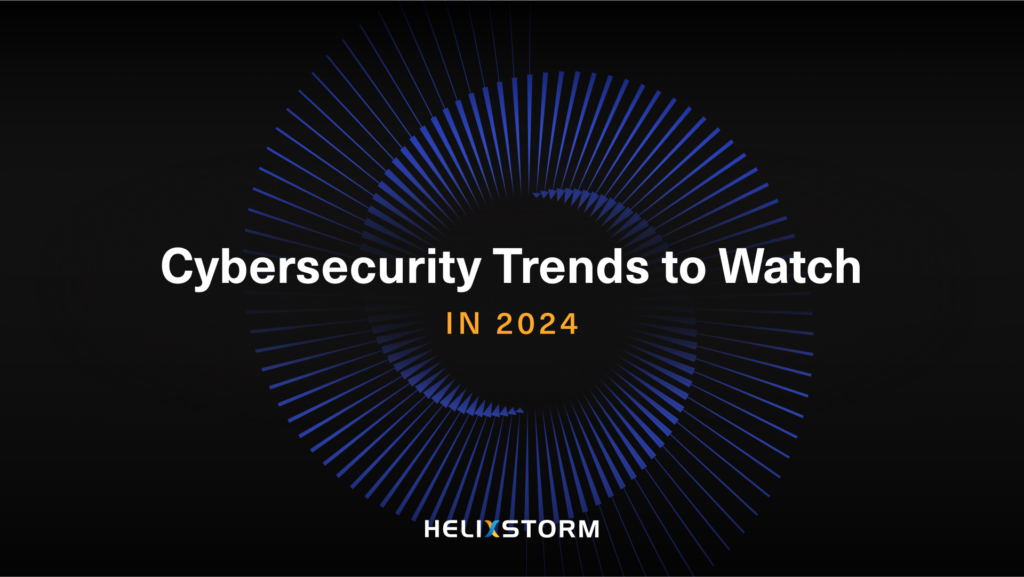
Understanding the latest trends in cybersecurity is crucial for businesses aiming to safeguard their operations. As technology evolves, so do the strategies of cybercriminals, making it a never-ending race to stay one step ahead.
In 2024, cybersecurity promises to be as dynamic and complex as ever, highlighting the need for companies to be well-prepared and resilient against digital threats. The annual costs associated with global cybercrime damages are projected to increase by 15% yearly for the next two years, reaching $10.5 trillion USD by 2025.
To provide you with the most effective strategies and insights into combating these threats, we will be sharing expert observations from Aaron Schneider, President of Helixstorm.
Let’s explore the key factors and strategies that will dictate the cybersecurity landscape in 2024 and prepare your business for the challenges ahead.
Table of contents
- Navigating two-way AI
- Fortifying systems with immutable backups
- Raising concerns: Ransomware as a service
- Advancing data privacy
- Addressing cloud security holes
- Securing third-party connections
- Confronting cybersecurity talent shortages
- Managing internal threats and remote work
- Guarding against social engineering attacks
- Bolstering Internet of Things (IoT) security
1. Navigating Two-Way AI
With AI’s advancements outpacing cybersecurity frameworks, organizations find themselves at risk. As artificial intelligence shapes the future, its role in cybersecurity acts both as a line of defense and a potential threat vector.
Attackers employ AI and machine learning to enhance their strategies to orchestrate more convincing phishing schemes and identify vulnerabilities. Yet, AI remains a critical asset in improving cybersecurity, enabling the development of systems that can promptly respond to threats.
AI equips businesses with advanced tools for threat detection, smart authentication, and automated responses. In the 2024 cyber battleground, AI stands as the pivotal force, potentially tipping the scales in favor of those who can most effectively harness its power.
2. Fortifying Systems with Immutable Backups
In the evolving landscape of cyber threats, the significance of robust data recovery strategies cannot be overstated. Aaron Schneider, President of Helixstorm, highlights the pivotal role of immutable backups in ensuring organizational resilience against ransomware attacks.
Immutable backups, which cannot be altered or deleted even by those with administrative rights, provide a fail-safe method for data recovery. They act as a critical line of defense against cybercriminals who leverage data encryption as a ransom tactic.
Aaron states that Helixstorm defended four cyberattacks against clients in 2023. By leveraging immutable backups, Helixstorm was able to swiftly restore the affected systems without succumbing to the demands of the attackers.
“We quickly recovered because we could take snapshots every two hours, so there was very little data loss. They were able to recover 100% because the threat actor could not delete the backups.
The role of immutable backups in ensuring data integrity despite attempts by attackers to compromise the system. It is a critical factor in their ability to recover without engaging with threat actors or paying ransoms,” Aaron says.
By integrating immutable backups into your cybersecurity strategy, your organization can significantly reduce a threat actor’s bargaining power and mitigate the impact of ransomware and other cyberattacks.
3. Raising concerns: Ransomware as a Service
In recent years, the cybersecurity landscape has seen a worrying rise in ransomware as a service (RaaS), a development Aaron Schneider highlights with concern. This trend represents a significant shift in how cybercriminals operate, making it easier for even those with minimal technical knowledge to launch ransomware attacks.
Aaron points out the escalated threat this poses to organizations of all sizes. “Many overlooked the growing trend of Ransomware as a Service during the pandemic. This development bolstered cybercriminals’ capabilities by adding non-technical individuals eager to make money to their ranks.”
This evolution in cybercrime democratizes access to sophisticated ransomware tools, enabling a broader spectrum of attackers to disrupt businesses and extort payments.
The sophistication and accessibility of RaaS platforms mean that the frequency and complexity of attacks are on the rise. “There is a constant evolution of threats, and the challenge is in defending against new or modified malware that is not yet recognized by security tools,” Aaron adds. This underscores how traditional cybersecurity measures may struggle to keep pace with the rapidly evolving tactics of these threat actors.
Aaron’s insights underscore the importance of continuously updating and fortifying cybersecurity defenses to protect against the dangers posed by RaaS. The adaptability and innovation of threat actors leveraging RaaS platforms demands a proactive and comprehensive approach to cybersecurity, emphasizing the need for resilience and constant vigilance in today’s digital environment.
4. Advancing Data Privacy
Data privacy is paramount across all sectors, with rising concerns over internet privacy and geopolitical cyber warfare. Maintaining rigorous data privacy measures is essential for addressing consumer worries and mitigating risks.
Good data hygiene isn’t just about avoiding data breaches. It also helps companies follow the law regarding how personal information should be treated. Plus, it shows customers that a company takes their privacy seriously.
In short, keeping data clean and well-managed is critical to protecting privacy and staying safe online.
5. Addressing Cloud Security Holes
Gartner predicts that by 2025, public cloud services will account for 51% of enterprise IT expenditures in major sectors, up from 41% in 2022. However, transitioning to the cloud can increase a company’s vulnerability to cyberattacks due to several factors, including:
- Cloud infrastructures that can obscure visibility and monitoring
- Human errors can cause misconfiguration of cloud settings
- Inadequate access controls that can allow unauthorized access
- Challenges in maintaining regulatory compliance across different jurisdictions
Additionally, misunderstandings about the shared responsibility model for security between cloud providers and clients can leave critical security tasks neglected. Insider threats and exploiting vulnerabilities in the APIs that manage and access cloud services further compound these risks.
To mitigate these vulnerabilities, companies migrating to the cloud in 2024 should engage in thorough planning, continuous security assessments, and adherence to cybersecurity best practices.
As reliance on cloud services intensifies, so does the necessity for stringent cloud security, given the vulnerabilities of misconfigurations and insufficient access controls. A solid security framework is crucial for safeguarding cloud environments.
However, according to Aaron, “In my experience, it’s a hundred times more possible for a digital disaster (like ransomware attacks) to occur than a physical disaster. While cloud-based backups recover data at secondary sites that protect against physical disasters, immutable backups protect against digital disasters. If you had to pick one or the other, choosing to protect yourself with immutable backups would put you in a really good spot.”
6. Securing Third-Party Connections
As businesses increasingly rely on third-party vendors, securing these external connections becomes crucial to prevent supply chain attacks and protect sensitive data. These partnerships can create vulnerabilities and expand the potential for cyber threats.
Examples of third-party connections include:
- Cloud service providers
- Software as a service (SaaS) applications
- Supply chain partners
- Payment processors and financial institutions
- IT service providers and consultants
- External data centers and infrastructure services
- IoT device manufacturers and service providers
To safeguard against these risks, it is essential to:
- Vet vendors thoroughly to ensure their security measures align with your standards.
- Conduct regular security audits of third-party partners to spot and address vulnerabilities.
- Limit access for third parties to only what’s needed, adhering to the principle of least privilege.
- Include security requirements in contracts to ensure clear expectations and responsibilities.
- Coordinate incident response plans with vendors for quick action in case of breaches.
- Monitor their activities continuously for any unusual or suspicious behavior.
- Educate employees on the risks associated with third-party connections and proper handling.
By implementing these strategies, organizations can mitigate risks from third-party connections, keeping their data and systems secure amidst interconnected business environments.
7. Confronting Cybersecurity Talent Shortages
The lack of skilled cybersecurity professionals presents a challenge, emphasizing the need for organizational investments in talent development and retention strategies to strengthen cybersecurity teams.
In response to the growing cybersecurity skills gap, the industry is pivoting towards innovative solutions in 2024. The approach combines increasing compensation to attract talent and significantly emphasizes talent development through training and upskilling programs.
These strategies aim not only to draw new professionals into cybersecurity but also to enhance the capabilities of existing ones to address the complex and evolving threat landscape effectively.
Helixstorm is a robust partner for businesses seeking to streamline their IT and cybersecurity efforts without the challenges of hiring and training specialized staff. Our managed IT services are expertly designed to augment or replace internal cybersecurity teams, providing organizations with the comprehensive support and protection they require.
From around-the-clock network monitoring to risk and compliance management, Helixstorm ensures businesses can focus on their core operations while staying secure and compliant.
8. Managing Internal Threats and Remote Work
The shift to remote work continues to present security challenges, notably increasing the risk of internal threats. Employees working from home may not have the same level of security oversight as in an office, raising the potential for issues such as data breaches.
It’s crucial for companies to educate remote workers on security best practices and to establish clear protocols to safeguard against these risks.
Integrating such training into the broader framework of remote work policies and practices reinforces the organization’s commitment to securing its digital assets against the evolving threat landscape.
Aaron Schneider emphasizes the importance of this education, particularly against phishing attacks, saying “You need to train your end-users NOT to click on phishing attempts.” By prioritizing cybersecurity awareness and training for remote employees, organizations can better protect themselves against the vulnerabilities of the remote work era.
Read 13 Security Tips For Working Remotely
9. Guarding Against Social Engineering Attacks
Social engineering attacks target the most unpredictable element of cybersecurity: the human factor. These attacks manipulate individuals into divulging confidential information or performing actions compromising security.
The sophistication of such schemes, often masquerading as legitimate requests, requires constant vigilance and a culture of cybersecurity awareness within organizations. Training employees to recognize and respond appropriately to these deceptive tactics is critical.
As Aaron Schneider points out, implementing proactive measures like simulation tools can significantly enhance this awareness. “A tool like KnowBe4 brands emails like it’s your company email. It’s an end-user security awareness training tool that sends ‘phishing emails’ to your emails and takes note of who fell victim to them,” he explains.
This approach tests employees’ ability to detect phishing attempts and provides a practical, hands-on learning experience. By fostering an environment where employees are educated and prepared for such attacks, organizations can fortify their defenses against the ever-present threat of social engineering.
In addition, endpoint detection, particularly through Managed Detection and Response (MDR) and EDR software, stands out as a frontline defense mechanism. This technology actively monitors individual devices for suspicious activities, ready to act based on predefined instructions.
As Aaron points out, “MDR/EDR software monitors individual devices for unusual activity. It will respond in whatever way you tell it.” The configurability of this software is crucial. It allows for tailored responses to detected threats, ranging from quarantine actions to the complete destruction of malicious entities.
Potential threats might slip through undetected without proper configuration, highlighting the importance of a strategic and well-configured deployment—an area where Helixstorm’s expertise provides significant value.
10. Bolstering Internet of Things (IoT) Security
The rapid spread of IoT technologies, while driving innovation across industries, has simultaneously unveiled a range of vulnerabilities. With each IoT device potentially serving as a gateway for cyber threats, comprehensive security measures are imperative to protect these interconnected systems.
Ensuring the safety of the IoT ecosystem is crucial for preventing data breaches and maintaining operational integrity. This encompasses implementing data encryption, access controls, secure device authentication, and conducting regular firmware updates. Additionally, fostering a culture of security awareness among employees is vital for the vigilant use of IoT devices.
By integrating these practices, organizations can leverage IoT technologies effectively while mitigating associated risks.
Navigate 2024’s Cybersecurity Landscape with Helixstorm
Cybersecurity challenges are evolving rapidly in 2024, emphasizing the need for organizations to stay ahead with robust defenses. Helixstorm offers top-notch Managed Security Services, blending 24/7 support with a tailored approach to IT.
We prioritize security, aiming to strengthen your infrastructure, reduce downtime, and ensure your network is both secure and efficient. With over 50 years of collective experience, our experts are dedicated to transforming vulnerable networks into future-proof, resilient systems.
Partnering with Helixstorm means addressing today’s cybersecurity trends and preparing for tomorrow’s challenges. Our team is ready to help you leverage your IT assets effectively and develop a scalable cybersecurity strategy. Schedule a free consultation to explore how we can secure your digital assets and future-proof your organization against 2024’s evolving cybersecurity threats.


